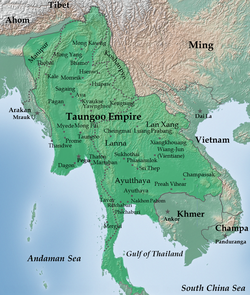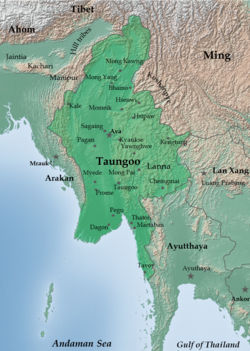

Toungoo dynasty
တောင်ငူမင်းဆက်
taungnguumainn saat | |||||||||||||||||
|---|---|---|---|---|---|---|---|---|---|---|---|---|---|---|---|---|---|
| 1510–1752 | |||||||||||||||||

Toungoo Empire at its greatest extent (1580)
| |||||||||||||||||

The restored Taungoo or Nyaungyan Dynasty c. 1650
| |||||||||||||||||
| Capital | Toungoo (Taungoo) (1510–39) Pegu (Bago) (1539–99) Ava (Inwa) (1599–1613) Pegu (Bago) (1613–35) Ava (Inwa) (1635–1752) | ||||||||||||||||
| Common languages | Official Burmese
Regional | ||||||||||||||||
| Religion | Official Theravada Buddhism
Minority | ||||||||||||||||
| Government | Absolute Monarchy | ||||||||||||||||
• 1485-1530 | Mingyi Nyo | ||||||||||||||||
• 1530–50 | Tabinshwehti | ||||||||||||||||
• 1550–81 | Bayinnaung | ||||||||||||||||
• 1605–28 | Anaukpetlun | ||||||||||||||||
• 1629–48 | Thalun | ||||||||||||||||
• 1733–52 | Mahadhammaraza Dipadi | ||||||||||||||||
| Legislature | Hluttaw | ||||||||||||||||
| History | |||||||||||||||||
• Founding of dynasty | 1485 | ||||||||||||||||
• Independence from Ava | 16 October 1510 | ||||||||||||||||
| 1510–1599 | |||||||||||||||||
| 1599–1752 | |||||||||||||||||
• End of dynasty | 23 March 1752 | ||||||||||||||||
| Population | |||||||||||||||||
• Census
| 1,982,000 - 2,313,000[citation needed] | ||||||||||||||||
| Currency | Ganza kyat and silver kyat | ||||||||||||||||
| |||||||||||||||||
| History of Myanmar |
|---|
 |
|
|
|
|
|
|
|
|
The Toungoo dynasty (Burmese: တောင်ငူမင်းဆက်, [tàʊɰ̃ŋù mɪ́ɰ̃ zɛʔ]; also spelt Taungoo dynasty), and also known as the Restored Toungoo dynasty, was the ruling dynasty of Burma (Myanmar) from the mid-16th century to 1752. Its early kings Tabinshwehti and Bayinnaung succeeded in reunifying the territories of the Pagan Kingdom for the first time since 1287 and in incorporating the Shan States for the first time, in addition to including Manipur, Chinese Shan States, Siam and Lan Xang.[1] At its peak, the Toungoo Empire was the largest and strongest empire in Southeast Asia. However, it collapsed in the 18 years following Bayinnaung's death in 1581.
The dynasty quickly regrouped under the leadership of Nyaungyan Min and his son, Anaukpetlun, who succeeded in restoring a smaller, more manageable kingdom, encompassing Lower Burma, Upper Burma, Shan States and Lan Na by 1622. The Restored Toungoo kings, now based in Ava (Inwa), created a legal and political system whose basic features would continue under the Konbaung dynasty well into the 19th century. The crown completely replaced the hereditary chieftainships with appointed governorships in the entire Irrawaddy valley and greatly reduced the hereditary rights of Shan chiefs. Its trade and secular administrative reforms built a prosperous economy for more than 80 years.
The kingdom entered a gradual decline due to the "palace rule" of its kings. Starting from the 1720s, the kingdom was beset with raids by the Meitei people of the Chindwin River, and a rebellion in Chiang Mai. Raids by the Meitei intensified in the 1730s, reaching increasingly deeper parts of central Burma. In 1740, the Mon peopleinLower Burma began a rebellion, founding the Restored Hanthawaddy Kingdom. The Hanthawaddy armies captured Inwa in 1752 and ended the 266-year-old Toungoo dynasty.
King Mingyi Nyo founded the First Taungoo Dynasty (1485–1569) at Taungoo far up the Sittaung River south of Inwa towards the end of the Ava Kingdom in 1510. After the conquest of Inwa by the Mohnyin-led Shan sawbwas in 1527, many Burmese-speakers migrated to Taungoo, which became a new centre.
Mingyi Nyo's son, King Tabinshwehti, unified most of Burma, consolidating his power and pushing southward, over-running the Irrawaddy Delta and crushing the Hanthawaddy capital of Bago. In 1544, Tabinshwehti was crowned as king of all Burma at the ancient capital of Bagan. By this time, the geopolitical situation in Southeast Asia had changed dramatically. The Shan gained power in a new kingdom in the north, the Ayutthaya Kingdom had established itself as a suzerain power around the Chao Phraya river basin, while the Portuguese Empire had arrived in the south and conquered Malacca.

With the coming of European traders, Burma was once again an important trading centre, and Tabinshwehti moved his capital to Bago due to its strategic position for commerce. He then began assembling an army for an attack on coastal Rakhine State to the west. Tabinshwehti's forces were defeated at Arakan but he was able to gain control of Lower Burma up to Pyay. He led his retreating army eastward to the Ayutthaya Kingdom, where he was again defeated in the Burmese–Siamese War (1547–49). A period of unrest and rebellions among other conquered peoples followed and Tabinshwehti was assassinated in 1550.
Tabinshwehti's brother-in-law, Bayinnaung, succeeded to the throne in 1550 and reigned 30 years, launching a campaign of conquest invading several states, including Manipur (1560) and Ayutthaya (1564). An energetic leader and effective military commander, he made Toungoo the most powerful state in Southeast Asia and extended his borders from LaostoAyutthaya. Bayinnaung was poised to deliver a final, decisive assault on the western kingdom of Arakan when he died in 1581. His son Nanda Bayin and his successors were forced to quell rebellions in other parts of the kingdom, and the conquest of Arakan was never achieved.
Faced with rebellion by several cities and renewed Portuguese incursions, the Toungoo rulers withdrew from southern Burma and founded a second dynasty at Ava, the Nyaungyan or Restored Taungoo Dynasty (1597–1752). Bayinnaung's grandson, Anaukpetlun (1605–1628), once again reunited Burma in 1613 and decisively defeated Portuguese attempts to take over Burma. Anaukpetlun's successor Thalun (1629–1648) rebuilt the war torn country. Based on Thalun's revenue inquest in 1635, the Irrawaddy valley's population was estimated to be around 2 million.[2]
The dynasty survived for another century and a half until the death of Mahadhammayaza in 1752. Encouraged by the French in India, Bago finally rebelled against Inwa, further weakening the state, which fell in 1752. The downfall of the Toungoo dynasty has been more broadly ascribed to institutional weaknesses in the capital, which intensified factionalism and succession disputes, and the uneven impact of growing trade and potential price inflation, on the elite's income streams.[3]
| Mingyi Swe V. of Toungoo ~1490s–1549 r.1540–1549 | Yaza Dewi ~1500-? Queen | Mingyi Nyo 1459–1530 r. 1510–1530 | Yadana Dewi 1490s-? Central Palace Queen | Soe Min Hteik-Tin ~1460s-~1530s Chief queen | |||||||||||||||||||||||||||||||||||||||||||||||||||||||||||||||||
| Dhamma Dewi ~1514/15-1580s Chief queen | Tabinshwehti 1516–1550 r. 1530–1550 | Khay Ma Naw Chief queen | Atula Thiri ~1518–1568 Chief queen | Bayinnaung 1516–1581 r. 1550–1581 | Khin Pyezon ~1530s-? Queen | Shin Htwe Myat | Sanda Dewi 1517/18–1580s? Chief queen | ||||||||||||||||||||||||||||||||||||||||||||||||||||||||||||||
| Hanthawaddy Mibaya ~1536–1606 Chief queen | Nanda 1535–1600 r. 1581–1599 | Nyaungyan 1555–1605 r. 1599–1605 | Khin Hpone Myint ~1560-1610s Chief queen | ||||||||||||||||||||||||||||||||||||||||||||||||||||||||||||||||||
| Atula Sanda Dewi Chief queen | Anaukpetlun 1578–1628 r. 1605–1628 | Khin Myo Myat | |||||||||||||||||||||||||||||||||||||||||||||||||||||||||||||||||||
| Min Lat | Mingala Dewi | Thalun 1584–1648 r. 1629–1648 | Khin Myo Sit | Khin Myat Hset | Minye Deibba 1608–1629 r. 1628–1629 | Khin Hnin Paw of Kengtung Chief queen | |||||||||||||||||||||||||||||||||||||||||||||||||||||||||||||||
| Ne Myo Ye Kyaw | Khin Ma Min Sit | Atula Sanda Dewi Chief queen | Pindale 1608–1661 r. 1648–1661 | Min Phyu Chief queen | Pye 1619–1672 r. 1661–1672 | Khin Ma Lat | |||||||||||||||||||||||||||||||||||||||||||||||||||||||||||||||
| Atula Thiri Chief queen | Minye Kyawhtin 1651–1698 r. 1673–1698 | Sanda Dewi | Narawara 1650–1673 r. 1672–1673 | ||||||||||||||||||||||||||||||||||||||||||||||||||||||||||||||||||
| Sanay 1673–1714 r. 1698–1714 | Maha Dewi Chief queen | ||||||||||||||||||||||||||||||||||||||||||||||||||||||||||||||||||||
| Taninganway 1689–1733 r. 1714–1733 | Mingala Dewi Chief queen | ||||||||||||||||||||||||||||||||||||||||||||||||||||||||||||||||||||
| Maha Dhamma Yaza 1714–1754 r. 1733–1752 | Nanda Dipadi Chief queen | ||||||||||||||||||||||||||||||||||||||||||||||||||||||||||||||||||||
During the Toungoo dynasty, the Burmese crown undertook a series of reforms that strengthened the stability and relative longevity of the dynasty. While the First Toungoo empire had established the precedent of stitching together independent kingdoms under a single monarch, Restored Toungoo monarchs more successfully subordinated lowland principalities under the Burmese throne's direct control.[3] Senior princes of these principalities were required to live at the Burmese capital under close supervision, and the ceremonial insignia of these provincial rulers was downgraded.[3] Other reforms included direct central control of provincial deputies, more effective links with provincial village chiefs, and expansion of the ahmudan system around the capital.[3] Beginning in 1635, the Burmese crown began to conduct comprehensive censuses, and consolidated access to provincial manpower and tax collections.[3] The Burmese monkhood in Upper Burma was also subject to more effective personnel and financial regulations.[3]
|
| |
|---|---|
| Pagan dynasty 849–1297 |
|
| Myinsaing and Pinya Kingdoms 1297–1364 |
|
| Sagaing Kingdom 1315–1364 |
|
| Kingdom of Ava 1364–1555 |
|
| Hanthawaddy Kingdom 1287–1539, 1550–1552 |
|
| Mrauk U Kingdom 1429–1785 |
|
| Prome Kingdom 1482–1542 |
|
| Toungoo dynasty 1510–1752 |
|
| Restored Hanthawaddy Kingdom 1740–1757 |
|
| Konbaung dynasty 1752–1885 |
|
| |
| Authority control databases: National |
|
|---|